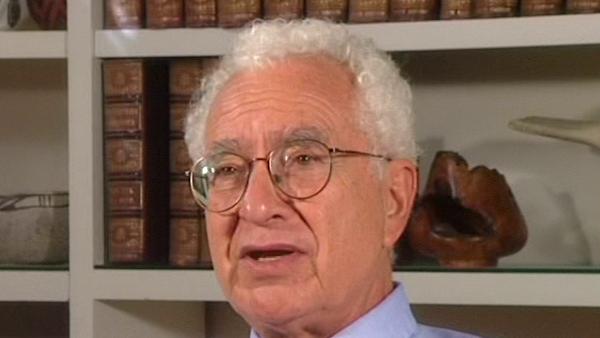NEXT STORY

London and Paris. Partially conserved axial vector current
RELATED STORIES

NEXT STORY

London and Paris. Partially conserved axial vector current
RELATED STORIES


|
Views | Duration | |
|---|---|---|---|
| 81. Electromagnetism, PCAC and global symmetry | 903 | 03:23 | |
| 82. The Stanford meeting of The American Physical Society | 903 | 01:55 | |
| 83. Muon and electron neutrinos | 939 | 01:12 | |
| 84. Collaborating with Feynman | 2962 | 02:40 | |
| 85. Global symmetry. Yang-Mill's theory. Phil Anderson | 1347 | 03:21 | |
| 86. Symmetry schemes | 825 | 03:16 | |
| 87. The Sakata model. A field theory model | 1181 | 02:28 | |
| 88. London and Paris. Partially conserved axial vector current | 783 | 02:31 | |
| 89. The Sigma model | 838 | 00:59 | |
| 90. Sheldon Glashow. The SU(2) times U1 theory | 1247 | 04:10 |


Another thing I did was to look at what was called the Sakata model. Although Dick Feynman and I developed it actually independently, we didn't publish it but we… we thought of it independently and worked with it a good deal. That was the supposition that somehow neutron, proton and lambda were fundamental, and the other particles were made out of them. Well that is an SU(3) scheme, but I didn't think of it in terms of SU(3); I thought of it in terms of S3, permutations among three things. Now, actually, mathematicians have shown that the representations of the permutation group and the representations of the unitary group are very closely related, so that I was able to construct the irreducible representations of SU(3) without knowing that I was working with SU(3) just by using permutations. And I actually did it. So I found the fifteen dimensional representation, for example, and the six dimensional representation and so on. And I thought that maybe that's where psi belonged, that we had n, p, and lambda and then sigma and psi belonged to a fifteen along with a lot of other particles that hadn't been seen yet, and so forth. I worked all that out mathematically, but it looked very ugly, so I didn't really sign on to it. But what I was doing was the Sakata model although of course I didn't assign that name to it since we had thought of it ourselves, and I had worked out these multiplets by myself. I didn't like it very much, but anyway I played with it. Likewise I played with a field theory model for the purpose of abstracting results in which I had three fundamental objects, like neutron, proton and lambda, and a single vector boson, giving a force among them. I knew this wasn't the right theory but I thought that some properties of the true theory could be abstracted from it. Later on, after the proposal of quarks, I used a three quark field theory with a single vector boson–no, a single neutral vector boson, knowing it was wrong but hoping that some correct results could be abstracted from it.
New York-born physicist Murray Gell-Mann (1929-2019) was known for his creation of the eightfold way, an ordering system for subatomic particles, comparable to the periodic table. His discovery of the omega-minus particle filled a gap in the system, brought the theory wide acceptance and led to Gell-Mann's winning the Nobel Prize in Physics in 1969.
Title: The Sakata model. A field theory model
Listeners: Geoffrey West
Geoffrey West is a Staff Member, Fellow, and Program Manager for High Energy Physics at Los Alamos National Laboratory. He is also a member of The Santa Fe Institute. He is a native of England and was educated at Cambridge University (B.A. 1961). He received his Ph.D. from Stanford University in 1966 followed by post-doctoral appointments at Cornell and Harvard Universities. He returned to Stanford as a faculty member in 1970. He left to build and lead the Theoretical High Energy Physics Group at Los Alamos. He has numerous scientific publications including the editing of three books. His primary interest has been in fundamental questions in Physics, especially those concerning the elementary particles and their interactions. His long-term fascination in general scaling phenomena grew out of his work on scaling in quantum chromodynamics and the unification of all forces of nature. In 1996 this evolved into the highly productive collaboration with James Brown and Brian Enquist on the origin of allometric scaling laws in biology and the development of realistic quantitative models that analyse the influence of size on the structural and functional design of organisms.
Tags: Richard Feynman, Dick Feynman
Duration: 2 minutes, 29 seconds
Date story recorded: October 1997
Date story went live: 24 January 2008